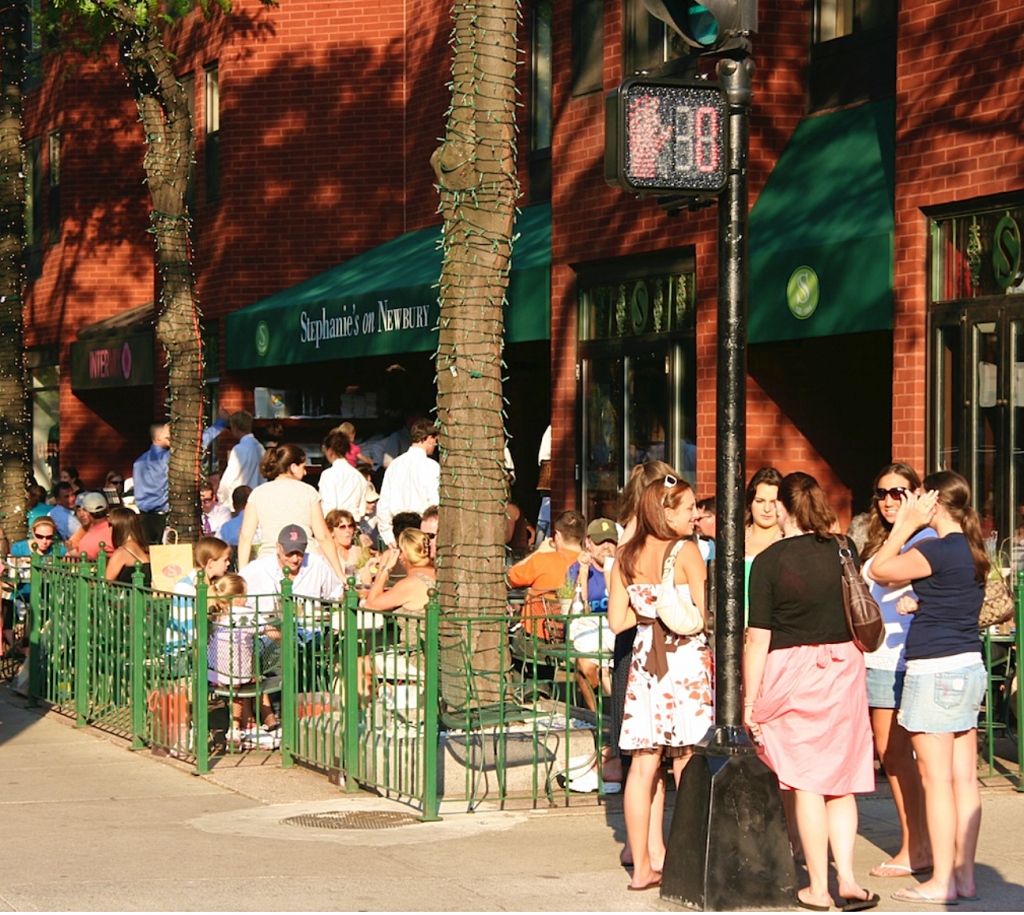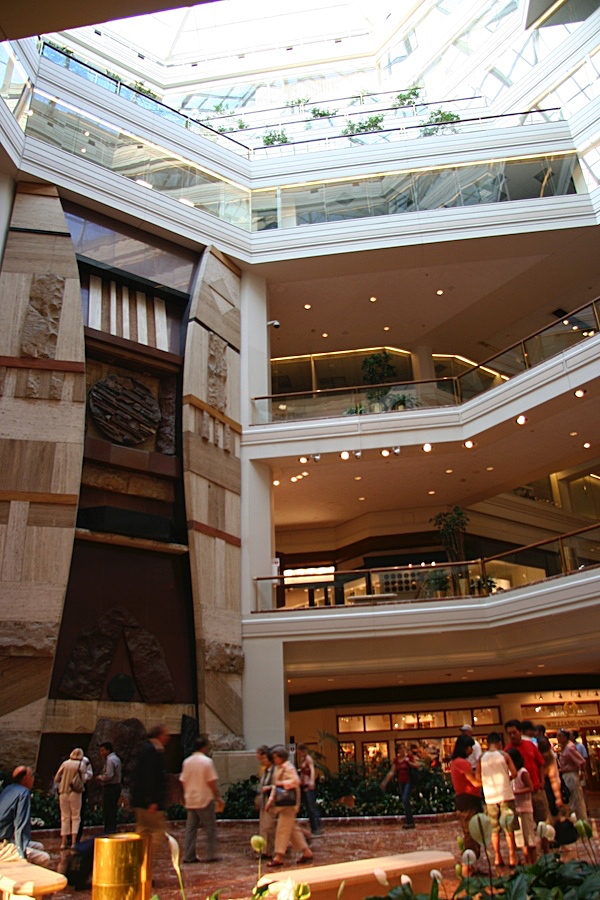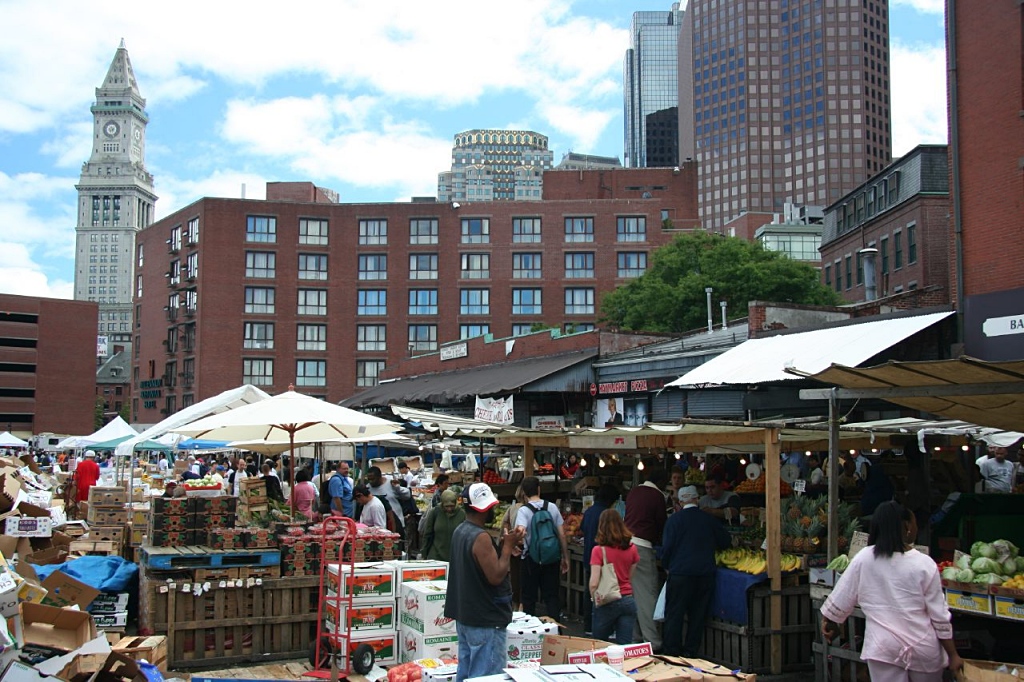Boston's Back Bay district is the city's epicenter of shopping, with several intense concentrations of upscale outlets, fashion boutiques and all-around good places to buy:
Copley Place
Just off Copley Square is the vast Copley Place complex, a posh shopping, dining, lodging, and entertainment community. There's even an elevated, glass-enclosed pedestrian walkway to the neighboring Prudential Center.
Neiman-Marcus is the big store here, but there are dozens of shops as well. Ralph Lauren, Williams-Sonoma, Saint Laurent Rive Gauche, Jaeger, Gucci, and Godiva, among others, all have outlets.
Shop hours are normally 10 am to 9 pm Monday through Friday, to 7 pm on Saturday, and noon to 5 pm on Sunday.
Prudential Center
This large Back Bay hotel, office and retail complex has more than 75 shops, boutiques and restaurants right next to the Hynes Convention Center.
Newbury Street
Boston's famous street of boutiques, galleries, and cafés runs from fashion to funk. Newbury Street starts at Arlington Street, right next to Burberrys' and the Taj Hotel, and the shoppers' and strollers' delights continue westward for half a dozen blocks.
Streets in the Back Bay were laid out in a grid. Cross streets running north-south were given names with initial letters running from A to H: Arlington, Berkeley, Clarendon, Dartmouth, and so on, so it's easy to know how far you are from the start of Newbury Street at Arlington Street.
Shops sell everything from the sublime (and expensive) to the ridiculous (and expensive). Galleries can be chic or somewhat traditional. Cafés are good and bad, expensive and cheap, and all possible permutations of those four qualities.

Shoppers take a break at a sidewalk café on Newbury Street.
Serious shoppers and gallery goers can consult the publications of The Newbury Street League which gives a list of most of the shops and some of the cafes along the street, their specialties, addresses, and phone numbers. Also, the Back Bay Association offers maps and info.
Newbury Street starts at the Taj, and the shops in the first few blocks are, naturally, the most expensive.
Emmanuel Church, just west of the Taj in the same block, lends a cool note of English Gothic and ivy to the polished-brass-and-marble of some of the shops. The church sponsors a variety of musical and theatrical programs—jazz, chamber music, choral recitals, puppet shows—and advertises current offerings on a wooden signboard in the side doorway.
The second cross street, then, is Berkeley, and in the block between Berkeley and Clarendon has more Gothic church architecture, this time in the form of the Church of the Covenant (Presbyterian), a bit plainer than the nearby Emmanuel. Organ recitals are held regularly at the Church of the Covenant, and usually a sign in the glass case will give the time.
Downtown Crossing
Once the epicenter of Boston shopping, this downtown pedestrian shopping district on Washington Street (MBTA subway Red Line or Orange Line to Downtown Crossing) is still important because of Macy's.
Its center is the corner of Washington, Winter and Summer streets (map), one long block southeast of Park Street Station on Boston Common. (Take the MBTA Red Line subway or the Orange Line to the Downtown Crossing station.)
Washington Street, the pedestrian thoroughfare of Downtown Crossing, has its own lineup of shops.
Across from Macy's, at 333 and 387 Washington Street, for instance, are entrances to the Jewelers' Building, a warren of little shops in a homely building. The building may not look like much, but the display cases in each shop are laden with fortunes in gold, diamonds, rubies, and emeralds. If you're at all interested in jewelry, take a stroll through here.
A short walk to the northeast along Washington Street brings you to Old South Meetinghouse, a historic Revolutionary War-era building that's part of the Boston National Historical Park.
Faneuil Hall Marketplace
Faneuil Hall Marketplace is a complex of historic buildings including Faneuil Hall and Quincy Market, flanked by the North and South Markets on either side. It's no Copley Place, but lots of people think it's lots more fun.
The complex is next to Government Center and the North End, and a 10- or 15-minute walk from Boston Common and Downtown Crossing (map). (Subway: Government Center or Haymarket.)
Faneuil Hall is the signature building, with retail shops at street level and its historic meeting hall (part of Boston National Historical Park) above.
Quincy Market, facing Faneuil Hall.
Historic Quincy Market is now a food-and-dining complex, with a variety of food shops in the main hall, a common dining area under the great dome, and fancier glass-covered sit-down restaurants along the sides of the building.
On one stroll through Quincy Market I noted the following items for sale (partial list): a dozen kinds of bagels right out of the oven on the premises, an infinite array of deli sandwiches, southern fried chicken, shish kebab, subgum chow mein, cheesecake, German blutwurst, French brie, Chateauneuf-du-Pape, live lobsters, mixed nuts, cold cuts (domestic and imported), rumpsteak, fresh doughnuts, and, at the clam bar, half a dozen cherrystone clams opened and ready to eat.
In the basement are various shops selling fish, meat, health foods, imported delicacies. On the second floor the emphasis is on crafts and exotic imports—rugs from Persia, jewelry from India, baskets from China and Mexico.
North Market and South Market are filled with retail shops, offices and several restaurants.
Faneuil Hall Marketplace is busy with crowds of customers from sunrise to late night every day of the week.
The granite block pavement between Faneuil Hall and Quincy Market's pillared classic Greek revival facade is usually occupied by street musicians, buskers, acrobats jugglers, mimes or clowns.
About the best purchase you can make here at Faneuil Hall Marketplace is half-price tickets to the theater, music and dance performances at more than 160 Greater Boston arts organizations from BosTix.
Faneuil Hall Marketplace is an all-year, day-and-night carnival you shouldn't miss, open for free.
Haymarket Square
Every Friday and Saturday, Haymarket Square, next to Faneuil Hall Marketplace, fills with fruit-and-vegetable vendors in Boston's weekly open-air produce market.


